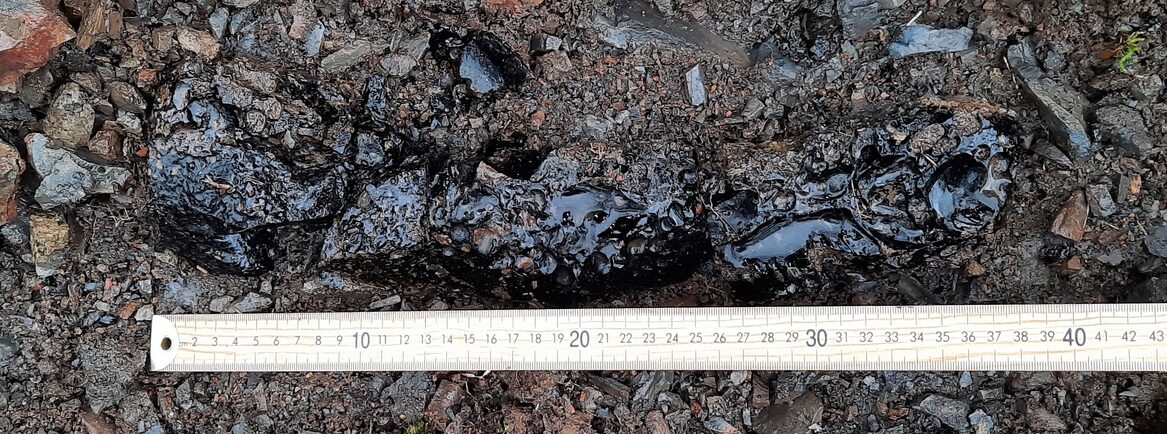Excavation November 22, 2017 - May 2, 2022
The Rebersburg fulgurite was discovered in November of 2015 near Rebersburg, Centre County, Pa., by a member of the Amish community, who we will refer to as Mr. Weaver to protect his privacy. According to Mr. Weaver, he was hunting on private property where there was about an inch of fresh sleet and snow covering the ground. As he walked along an unpaved road through the woods, he came upon what he described as the site of a “large hot fire that had exploded.” He stated, “There were dozens of pieces of something black scattered on the snow. I remembered thinking ‘this is pretty, whatever it is.’ I stood there for10 minutes or more. I recall it so vividly. I was confused because I knew something unusual happened, but I had no idea what it was.” He then left the area to continue hunting.
A year later, in the fall of 2016, Mr. Weaver took his daughter and son on a hike to the same area. He came upon the site and found shards of black glass scattered among the fallen leaves (Figure 1). He gathered a few pieces and noticed a large chunk of what appeared to be black glass protruding from the ground (Figure 2).
In late November of 2017, Mr. Weaver and his friend took Dr. Loretta Dickson and Dr. Joseph Calabrese from Lock Haven University to the location of the black glass. There, they exposed, documented, and excavated most of the fulgurite. During the past several years, the entire fulgurite has been excavated. The fulgurite consisted of a 5-meter- (16.4-foot-) long central axis that extended in an east-west direction along the center of the unpaved road (Figure 3 and 4). The top of the fulgurite was several centimeters below the road surface. At least five bifurcating branches extended 2 m perpendicular to the central axis. Four branches extended to the south, and one branch extended to the north (Figure 5). The central axis and four bifurcating branches that extended perpendicular to the central axis probably correspond to the path of the lightning as it dispersed into the ground.
The interior of the central axis consisted of a solid black- and brown-colored glass core that measured up to 20 cm across with large (3 to 4 cm) vesicles distributed along the length of the fulgurite core (Figure 6). In many places, the central glass core was absent of vesicles and occurred as a solid flattened cylinder of black glass exhibiting a subconchoidal to conchoidal fracture. The largest recovered section was solid black glass 10 by 20 cm in cross section and 56 cm in length; it weighed more than 20 kg (Figure 7).
The interior core of the central axis was rimmed by a 2-cm zone of pumiceous material with a high concentration of small vesicles that ranged in size from 0.2 to 2 mm. The pumiceous zone thinned to 2 mm at the top of the fulgurite. The pumiceous zone was coated with a thin (1 to 3 mm) rim of partly fused rock fragments (Figure 8), giving the fulgurite a rough outer surface. The rock fragments consisted mostly of siltstone and shale.
The bifurcating branches decreased in diameter with distance from the central axis. A nearly round 14.5-cm-long section measuring 4 by 5 cm formed a solid rod of black glass with a partly fused rock fragment included in the glass visible on the broken end. Vesicles on top of it were distorted and appeared to wrap around the branch. The lower part of the branch retained a 1-cm pumiceous zone and a thin outer coating of rock fragments. Another sample showed a bifurcation into two branches that separated to project approximately 35° from one another. This sample contained large internal vesicles that gave the branch a hollow appearance.
The broken ends of two fulgurite branches contained multiple distorted vesicles that occurred in a stacked configuration. The vesicles ranged from 1 to 3 cm along the longest axis. The vesicles were flattened in the horizontal direction, curved, and concave downward. Some of the pumiceous material had a specific gravity less than one and floated in water. The distorted shape of the stacked vesicles may be explained by the motion of gas bubbles rising while the material was in a molten but highly viscous state. The uppermost bubble became distorted as a bubble from below moved upward and impinged on its space. The repeated upward movement of multiple bubbles distorted each overlying bubble, producing the stacked, concave-downward bubble configuration.
The central axis varied along its length from flattened cylinders with multiple vesicles that gave a hollow appearance to solid, flattened cylinders of glass that lacked vesicles. The solid glass cores may be explained by gas bubbles coalescing and escaping before the molten cylinder solidified. This process likely occurred only in some places along the central axis and not along the entire length of the fulgurite, due to slight variations in the viscosity of the molten material based on the composition of soil and rock fragments. Because the gravel-sized shale fragments contain less silica than the soil, a higher shale-to-soil ratio would result in a less viscous melt. Gas bubbles in a lower viscosity melt would have a greater propensity to coalesce and rise through the melt, leaving behind bubble-free material.


